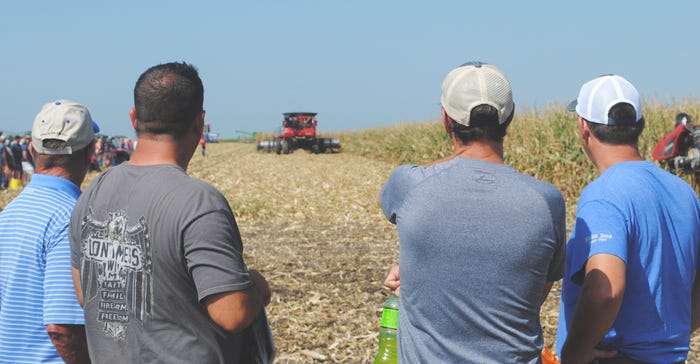
We like to say that Husker Harvest Days started in 1977 when the first soil was turned on the show-site fields in preparation for the first official show in the fall of 1978. That is true.
However, the spirit of Husker Harvest Days began much earlier in the state, perhaps with the state and national hand cornhusking contests that were popular from the 1920s through 1941 and the onset of U.S. involvement in World War II.
In the 150th anniversary issue of Nebraska Farmer published in 2009, Jim Carlton dug into those old contests. He reported that Nebraska Farmer served as an early cheerleader for the competitions, seeking “agricultural athletes” to compete in the first state hand cornhusking contest in October 1924.
National cornhusking contests were rotated around Midwest states, and were held in Nebraska beginning in 1926 in Fremont, and again in 1933 at the Ben Stalp farm near West Point. It was estimated that 45,000 fans, along with NBC radio’s best-known sports announcer, Hal Totten, attended the event on a cold fall day.
That year, the national championship went to a true “cornhusker,” 38-year-old Lancaster County farmer Sherman Henriksen, who picked 38.36 bushels against 46 other huskers from across the country.
In addition to the actual contest, there were farm machinery exhibits and demonstrations. The Stalp farm looked like a small, tented city, according to reports of the day. International Harvester Co. brought carloads of farm equipment, along with Allis-Chalmers Co., Firestone Tire Co. and the Goodyear Tire Co., among others.
There were plowing and mechanical corn-picking demonstrations that were held as part of the contest festivities. One state contest in 1937 held in Kearney included, interestingly enough, a pump irrigation demonstration.
Over the years that followed, hand cornhusking became somewhat of a lost art as mechanical harvest means became the norm, but the contests were revived in the mid-1970s and continue today, although they are a bit subdued compared to those early days.
HHD connection
Husker Harvest Days, which runs this year from Sept. 14-16 in Grand Island, Neb., is connected to those early cornhusking contests in a palpable way. Instead of the hand-husking peg or a husking hook, today’s popular corn harvest demonstrations at HHD are accomplished with high-tech combines that can harvest Henriksen’s 38.36 hand-husked bushels in a few seconds.
The stars of today’s HHD are not necessarily farmer cornhuskers, but the technology, equipment and systems that get the job done on modern farms, as well as the engineers and manufacturers that make them.
Prep for first show
Over the 40-plus years of HHD, there have been many memorable shows, going back to the beginning. In our official show program during the 40th anniversary year of HHD, former Nebraska Farmer editor Don McCabe reflected on his days at HHD. McCabe, during his tenure at Nebraska Farmer, never missed a show, including the day when the first show-site preparations were made in 1977.
“To the naked eye,” McCabe recalled, “the show site was a flat piece of ground, but they had to spend a day tilling the soil to convert it from pasture to cropland, and brought out a land-leveling machine to level it for gravity irrigation, which was still the prominent irrigation method at the time. At the end of the day, they lined up the tractors they had brought out that day for a photo.”
Recalling 9/11
Of all the shows that McCabe attended, there is one that sticks out for him personally. “None of us who were present the first day of the show on Sept. 11, 2001, can forget the major shock of the terror attacks and the resulting impact on the crowds that day,” McCabe wrote in 2017.
Exhibitors and visitors huddled around a few TVs in exhibit booths as they tried to comprehend the tragedy. It was a subdued crowd, to say the least, McCabe said.
“Flags lining Flag Road into the show grounds were lowered to half-staff, and people walking nearby wondered why we were doing so,” he added. Today, whenever the show falls on Sept. 11, the tradition is that the flags along the main entrance — Flag Road — continue to be lowered to half-staff.
New infrastructure
There was a time when adding permanent restroom facilities was a huge upgrade to the site. But in more recent years, more than $7.5 million was invested into the HHD show site, which included 5.5 miles of newly paved streets, 3.5 miles of storm sewer pipe, 1.5 miles of security fence around the exhibit area, and 34 miles of electrical wiring to upgrade and weatherproof the 2.6 million square feet of exhibit space.
This was all done in partnership between the county, city, private partners and Informa, the parent company of the show and Nebraska Farmer.
New memories
After last year’s COVID cancellation of the in-person show, the Husker Harvest Days team — along with editorial staff from Farm Progress, including Nebraska Farmer — are excited to be back, looking forward to seeing old friends again, and enthusiastic about the new technologies and new equipment that will be exhibited, many for the first time at HHD this year.
Learn about Husker Harvest Days’ schedule of events, directions to the show and much more at huskerharvestdays.com.
About the Author(s)
You May Also Like






